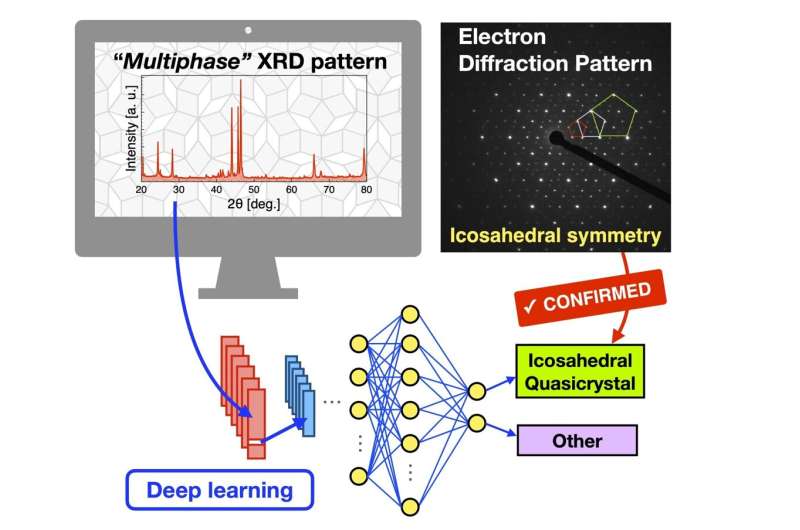This article has been reviewed according to Science X's editorial process and policies. Editors have highlighted the following attributes while ensuring the content's credibility:
fact-checked
peer-reviewed publication
trusted source
proofread
Deep learning model can detect a previously unknown quasicrystalline phase

Crystalline materials are made up of atoms, ions, or molecules arranged in an ordered, three-dimensional structure. They are widely used for the development of semiconductors, pharmaceuticals, photovoltaics, and catalysts.
The type of structures that fall into the category of crystalline materials continues to expand as scientists design novel materials to address emerging challenges pertaining to energy storage, carbon capture, and advanced electronics.
However, the development of such materials necessitates precise ways of identifying them. Currently, powder X-ray diffraction is widely used for this purpose. It identifies the structure of crystalline materials by examining scattered X-rays from a powdered sample. However, the task of identification becomes quite complex when dealing with multiphase samples containing different types of crystals with distinct structures, orientations, or compositions.
In such cases, the accurate identification of the various phases present in the sample relies on the expertise of scientists, making the process time-consuming. To expedite this process, innovative data-driven methods, such as machine learning, have been used for distinguishing individual phases within multiphase samples.
While substantial progress has been made in utilizing them for collecting information about known phases, the identification of unknown phases in multiphase samples still remains a challenge.
Now, however, researchers have proposed a new machine learning "binary classifier" model that can identify the presence of icosahedral quasicrystal (i-QC) phases—a kind of long-range ordered solids that have self-similarity in their diffraction patterns—from multiphase powder X-ray diffraction patterns.
This study involved collaboration among Tokyo University of Science (TUS), National Defense Academy, National Institute for Materials Science, Tohoku University, and The Institute of Statistical Mathematics. It was led by Junior Associate Professor Tsunetomo Yamada from TUS, Japan, and was published in the Advanced Science journal on 14 November 2023.
"Across the world, researchers have made attempts to predict new substances using artificial intelligence and machine learning. However, identifying whether a desired substance is produced takes up substantial time and effort on the part of human experts. Therefore, we came up with the idea of using deep learning to identify new phases," explains Dr. Yamada.
For developing the said model, the researchers first created a "binary classifier" using 80 types of convolutional neural networks. They next trained the classifier model using synthetic multiphase X-ray diffraction patterns, which were designed as representations of the expected patterns associated with i-QC phases. Following the training phase, the model's performance was assessed using both synthetic patterns and a database of actual patterns.
Quite interestingly, the model achieved a prediction accuracy of over 92%. It also successfully identified an unknown i-QC phase within multiphase Al–Si–Ru alloys when used for screening 440 measured diffraction patterns from unknown materials in six different alloy systems. The presence of the unknown i-QC phase was further confirmed on analyzing the microstructure and composition of the material using transmission electron microscopy.
Notably, the proposed deep learning method has the ability to identify the i-QC phase even when it is not the most prominent component in the mixture. Moreover, this model can be used for the identification of new decagonal and dodecagonal QCs and can be extended to various types of other crystalline materials as well.
"With the proposed model, we were able to detect unknown quasicrystalline phases present in multiphase samples with high accuracy. The accuracy of this deep learning model thus points to the possibility of accelerating the process of phase identification of multiphase samples," concludes Dr. Yamada. Moreover, Dr. Yamada and his team are confident that this model will lead to a breakthrough in the field of materials science.
In summary, this study is a significant step forward in the identification of entirely new phases in quasicrystals commonly found in materials such as mesoporous silica, minerals, alloys, and liquid crystals.
More information: Hirotaka Uryu et al, Deep Learning Enables Rapid Identification of a New Quasicrystal from Multiphase Powder Diffraction Patterns, Advanced Science (2023). DOI: 10.1002/advs.202304546
Journal information: Advanced Science
Provided by Tokyo University of Science





















